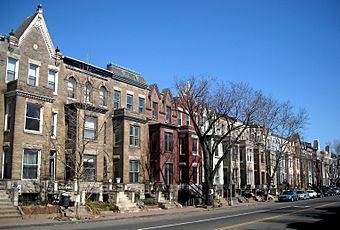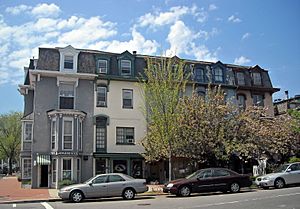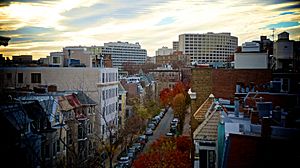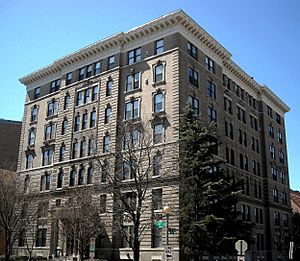Strivers' Section Historic District facts for kids
|
Strivers' Section Historic District
|
|

Rowhouses on the 1700 block of U Street NW
|
|
 |
|
| Location | Washington, D.C. |
|---|---|
| Built | 1875–1925 |
| Architectural style | Beaux-Arts, Italianate, Queen Anne, Romanesque Revival, Second Empire, Tudor Revival |
| NRHP reference No. | 85000239 |
Quick facts for kids Significant dates |
|
| Added to NRHP | February 6, 1985 |
The Strivers' Section Historic District is a special area in Washington, D.C., located in the Dupont Circle neighborhood. It's known for its beautiful old buildings. In the late 1800s and early 1900s, this district was home to many successful and important African Americans. They were often leaders in their community.
The name "Strivers' Section" comes from a writer who called it "the Striver's section, a community of Negro aristocracy." It's similar to "Strivers' Row" in Harlem, New York City, another historic area where black professionals lived. The district has about 430 historic buildings, mostly apartment buildings and rowhouses. Famous people like Frederick Douglass and his son Lewis Henry Douglass once lived here. The area became a historic district in 1983 and was added to the National Register of Historic Places in 1985.
Contents
Exploring the Strivers' Section
The Strivers' Section Historic District is in the northern part of Dupont Circle. It's bordered by Swann Street to the south and Florida Avenue to the north and west. Major streets like 17th Street, 18th Street, New Hampshire Avenue, and U Street run through it.
Most of the buildings in this district were built between 1875 and 1946. They show off different styles of architecture. These include Italianate, Queen Anne, Romanesque Revival, and Second Empire. Some buildings, like Old Engine Company No. 9 and several apartment buildings, are considered "contributing properties." This means they help make the district historically important.
A Look Back: History of the District
Early Days and Growth
The area where Strivers' Section now stands was planned as part of Washington, D.C., way back in 1791. However, it stayed mostly rural for many years. In the mid-1800s, it was still undeveloped, with only a few scattered houses.
During the American Civil War, military camps were set up nearby. One camp, Camp Barker, became a safe place for African Americans. This helped create new neighborhoods for the city's black residents.
The arrival of horse-drawn streetcars along 14th Street in the 1860s sparked new interest in the area. Developers bought land, seeing its potential. One of these developers was Henry A. Willard, who founded the famous Willard Hotel. A street in the district is named after him.
In the early 1870s, city improvements led to a building boom. Over 150 houses were built between 1873 and 1875. This changed the rural area into a busy neighborhood. Some of these original buildings, like Italianate homes on 17th Street, still stand today.
A Home for Leaders

At first, the neighborhood had a mix of working-class people and professionals, both African American and white. But it soon became known as a place for the African American middle class and elite. They were drawn to the area because of public transportation and the nearby Howard University.
One famous resident was Frederick Douglass, a writer and statesman. In 1877, he bought three homes on 17th and U Streets as an investment. His son, Lewis Henry Douglass, lived at 2002 17th Street NW for over 30 years. The money Frederick Douglass earned from these properties helped him financially in his later years.
More development happened after electric streetcar service started on U Street in 1893. Many of the district's buildings, especially Queen Anne-style houses, were built in the next two decades. The neighborhood also started to have more white middle-class residents, though people of different races often lived on separate streets.
The 20th Century and Beyond
In the early 1900s, larger homes and apartments were built for the middle class. Important residents included James C. Dancy, the city's Recorder of Deeds, and Joseph Lealand Johnson, a professor at Howard University. Architect Calvin Brent, who designed St. Luke's Episcopal Church, also lived and worked in the area. Many well-known architects designed buildings here, including Thomas Franklin Schneider and B. Stanley Simmons.
By the 1920s, U Street became a hub for African American businesses and entertainment. The Strivers' Section changed again, becoming mostly a middle-class African American community. The nickname "Strivers' Section" became popular during this time. While it was sometimes used to describe people "striving" to move up in society, it was also seen as a positive term. Social historian William Henry Jones praised the "negro pioneers" who made homes in this area.
Some white residents tried to create rules that would prevent African Americans and Jews from living on certain streets. These rules were challenged in court. Even though the rules were initially allowed, many prominent African Americans continued to live in Strivers' Section.

In 1948, the Supreme Court ruled that racially restrictive rules were illegal. This meant African American residents could live in any neighborhood they chose. Over the next few decades, the area faced challenges, including poverty and crime, especially after the 1968 Washington, D.C., riots. However, most of the historic buildings were saved from major changes.
In the early 1980s, the Strivers' Section was officially recognized as its own historic district. This helped protect its unique character and history. Since then, many buildings have been restored, and new developments have brought a diverse group of people to live in Strivers' Section.


